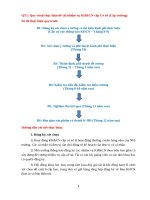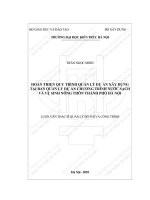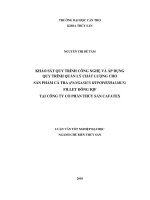39 đánh giá rủi ro và quy trình quản lý
Bạn đang xem bản rút gọn của tài liệu. Xem và tải ngay bản đầy đủ của tài liệu tại đây (91.84 KB, 8 trang )
<span class="text_page_counter">Trang 1</span><div class="page_container" data-page="1">
1. MỤC ĐÍCH
Để kiểm sốt hiệu quả các nguyên liệu và sản phẩm của công ty trong quá trình lưu trữ, sản xuất, vận chuyển đảm bảo chất lượng an toàn sản phẩm.
4.1 Tất cả các bộ phận sử dụng liên quan chịu trách nhiệm quản lý và kiểm sốt ngun liệu thơ bán thành phẩm, thàngh phẩm, thiết bị công nghệ và đồ đạc của bơ phận
4.2 Phịng hành chính chịu trách nhiệm theo dõi đánh giá toàn bộ kế hoạch
4.3 Phòng kỹ thuật chịu trách nhiệm đánh giá kịp thời các vật liệu. quy trình, thiết bị và đồ đạc mới 4.4 Kho chứa trách nhiệm bảo vệ và quản lý nguyên liệu
4.5 Bộ phận sản xuất chịu trách nhiệm kiểm tra việc quản lý và kiểm soát nguyên liệu và bán thành phẩm , thành phẩm ở các phòng ban khác nhau
4.6 Phòng quản lý chất lượng chịu trách nhiệm kiểm tra quản lý nguyên liệu và bán thành phẩm, thành phẩm ở các phịng ban khác nhau
5. QUY TRÌNH
5.1 Phân tích và đánh giá rủi ro
- Đánh giá rủi ro được tiến hành ít nhất mỗi năm một lần, khi nhập mới các vật liệu, thiết bị, công cụ và quy trình thay đổi phải đáng giá rủi ro
- Ảnh hưởng từ thế giới bên ngoài,do ảnh hưởng của ngoại lực, chất lượng vật liệu và sản phẩm có thể bị ô nhiễm, chẳng hạn như phá hoại của ngoại lực, làm cho kính cửa sổ bị vỡ, rơi vào sản phẩm, phá huỷ chất lượng sản phẩm.
- Tác động của thiên tai : các thảm hoạ tự nhiên như mưa lớn, bão , động đất… có thể ản hưởng đến chất lượng sản phẩm.
- Tác hại lưu trữ hố chất : hố chất khơng đúng thùng chứa không được đậy nắp, một số lượng lớn các hố chất trộn lẫn với sản phẩm, có thể có tác động huỷ hoại đến chất lượng sản phẩm, người dùng hố chất khơng được mặc đồ bảo hộ theo u cầu và hố chất có thể gây hại cho sức khoẻ con người.
</div><span class="text_page_counter">Trang 2</span><div class="page_container" data-page="2">- Phá huỷ sinh học: Các loại con trùng có mặt trong mơi trường sản xuất, có thể cắn sản phẩm, phân của động vật có thể làm nhiễm bẩn đến sản phẩm và sự hiện diện của vi sinh vật có thể ăn mịn sản phẩm.
- Nhà máy không thu thập kịp thời các tiêu chuẩn công nghiệp và tiêu chuẩn an toàn dẫn đến các sản phẩm khônh đáp ứng yêu cầu
- Tương tác vật chất : Ảnh hưởng của các vật liệu với nhau ; Thời gian lưu trữ vật liệu quá dài và có thể do axit và kiển trong khơng khí gây ra, có thể khiến sản phẩm thay đổi chất lượng, việc lưu trữ trong một thùng chưa quá nhiều hoặc xếp chồng lên nhau quá cao và có thể bị biến dạng. Các vật liệu khác nhau được trộn lẩn với nhau, và những thay đổi về chất có thể sảy ra do sự khác biệt về vật liệu - Sự không phù hợp của các nguyên liệu thổ chủ yếu là các nguyên liệu thô bị bẩn ướt và hết hạn. Việc lưu trữ nguyên liệu, lưu ý rằng mỗi loại pallet chỉ để một loại sản phẩm và bảo vệ bao bì khỏi bị hư hại, tránh tiếp xúc với mưa bên ngoài, hãy sử dụng nguyên tắc FIFO và trước khi phân phát kiểm tra sản phẩm có bất thường khơng
- Cơng thức chính xác cho vật liệu : Ngun vật liệu khơng chính xác được sử dụng trong ngun liệu thô sẽ trực tiếp dẩn đến sự khác biệt và hiệu suất sản phẩm. Để ngăn ngừa các lỗi đó, ngun liệu thơ được quản lý sản xuất xem xét trước khi sản xuất co hướng dẩn cho nhân viên, người quản lý sản xuất phải kiêrm tra xem các nguyên liệu thô được sử dụng có phù hợp với cơng thức đạt hàng sản xuất hay không, sau khi nhân viên kiểm tra nguyên liệu thơ được sử dụng có phù hợp với cơng thức đạt hàng sản xuất hay không, sau khi kiểm tra nguyên liệu thô với các chứng từ và khơng có vấn đề mới tiến hành hoạt động sản xuất.
* Lỗi tham số quy trình sản xuất
Bao gồm tốc độ máy, nhiệt độ, lỗi cài đặt thông số kỹ thuật sảm phẩm những điều này sẽ ảnh hưởng trực tiếp đến tính phù hợp của sản phẩm. Khi bắt đầu sản xuất nhân viên kiểm tra chất lượng phải thực hiện kiểm tra cái đầu tiên của sản phẩm được sản xuất đáp ứng yêu cầu quy cách và tính năng của khách hàng
* Tai nạn thiết bị và phương tiện
Bap gồm thiệt hại cho thiết bị và phương tiện, mất điện ngồi dự kiến , hảo hoạn… Trong cơng việc hàng ngày, công ty sắp xếp nhân viên chuyên môn để thực hiện kiểm tra hàng ngày, hàng tuần và hàng tháng và bảo trì thiết bị tìm ra các vấn đề tiềm ẩn kịp thời. Cơng ty nên có một bô máy phát điện để chuẩn bị cho nhu cầu càn thiết, để phong cháy chữa cháy, công ty có quản lý an tồn chịu trách nhiệm quản lý các cơ sở phòng cháy chữa cháy huấn luyện phòng cháy chữa cháy và loại bỏ các nguy cơ hoạn
* Tình trạng làm việc của người vận hành an tồn cơng nghiệp
</div><span class="text_page_counter">Trang 3</span><div class="page_container" data-page="3">Sản phẩm do nhân viên thao tác sản xuất ra , để loại bỏ sự khác biệt trong công việc của con người, các quy trình vận hành hoặc hướng dẫn công việc đã được thiết lập cho các thiết bị sản xuất khác nhau để hướng dẩn nhân viên tuân thủ theo các hoạt động được tiêu chuẩn hoá , Thiết lập chế độ nghĩ ngơi để đảm bảo rằng nhân viên ở trong tình trạng làn việc bình thường, giáo dụ an tồn theo nhiều cách khác nhau , chủ động sử dụng các biện pháp phòng ngừa tai nạn tại nơi làm việc.
5.2 Tiêu chí đánh giá mối nguy và phân loại mối nguy
- Theo khả năng của mối nguy hiểm và mức độ nghiêm trọng của mối nguy hiểm , mối nguy hiểm được chia thành bốn cấp độ như trong bảng sau :
Đánh giá rủi ro nguy cơ
Khả năng gây hại
1. Xác suất xảy ra : thường xuyên – thường xuyên sảy ra, người tiêu dùng tiếp tục bộc lộ, thường – xảy ra nhiều lần người tiêu dùng thường bộc lộ, thỉnh thoảng – sẽ sảy ra hoặc lẽ tẻ , Hiếm khi – có sảy ra, hiếm khi sảy ra với người tiêu dùng , không thể - hiếm khi người tiêu dùng.
2. Hậu quả của mối nguy hiểm : Thảm khốc – dẫn đến tử vong . nghiệm trọng – gây ra bệnh nựng hoặc thương tích. Trung bình – gây bệnh nhẹ . Khơng đáng kể - Gây khó chịu, nhưng khơng gây bệnh hoặc thương tích.
3. Đáng giá rủi ro về mối nguy hiểm : Rủi ro rất cáo ( A ), Rủi ro cao ( B ) , Trung bình ( C ) , rủi ro thấp ( D ) theo màu khác nhau
5.3 Quản lý vật liệu
</div><span class="text_page_counter">Trang 4</span><div class="page_container" data-page="4">khơng, tường có bị bong tróc hay khơng và khu vực lưu trữ của sản phẩm có được giữ khoảng cách 60cm so với của ra vào hay không
- Chú ý đến việc thay đổi thời tiết và bảo vệ sản phẩm trước thiên tai.
- Hoá chất được thiết lập trong nhà kho chuyên dụng , được phân vùng , xưởng không được giữ lại mơt lượng lớn hố chất, hố chất được đậy kín và bảo quản và thiết lập thùng chứa thứ hai , các hoá chất được sử dụng tránh tiếp xúc với các sản phẩm khác , và hoá chất trong xưởng được đưa lại kho khi không sử dụng đến
- Giữ môi trường nhà máy gọn gàng sạch sẽ, thường xuyên diệt côn trùng, đặt lồng chuột
- Vật liệu được chia thành các tầng ngăn và chiều cao khong quá 2 mét, Các vật liệu khác nhau không được trộn lẫn với nhau, cấp phát nguyên liệu thực hiện theo quy tắc nhập trước xuất trước
- Sau khi kiểm tra nhập liệu đạt tiêu chuẩn , các vật liệu mới có thể đưa vào kho sản xuất, các vật liệu không đủ tiêu chuẩn cần đánh giá mới xử lý , việc bảo quản và lưu trữ vật liệu kho phải thực hiện theo quy trình quản lý kho hàng .
- Quản lý sản xuất trước khi xuất phải kiểm tra vật liệu và công thức đặt hàng một cách nhất quán ,và thực hiện kiểm tra cái đầu tiên trước khi sản xuất hành loạt, và nhân viên PQC sẽ tiến hành kiểm tra thường xuyên trong q trình sản xuất
- Các thơng số của máy móc và thiết bị phải đạt theo đúng quy trình vận hàng hoặc hướng dẩn công việc , nghiêm cấm nhân viên tự ý điều chỉnh.
1. PURPOSE
</div><span class="text_page_counter">Trang 5</span><div class="page_container" data-page="5">To effectively control the company's materials and products during storage, production, and transportation to ensure product quality and safety.
4.1 All relevant user departments are responsible for the management and control of semi-finished raw materials, finished products, technological equipment and department fixtures.
4.2 Administration department is responsible for monitoring and evaluating the entire plan
4.3 The technical department is responsible for the timely assessment of materials. new processes, equipment and fixtures
4.4 Warehouse responsible for protection and management of raw materials
4.5 Production department is responsible for checking the management and control of raw materials and semi-finished products, finished products in different departments.
4.6 Quality control department is responsible for controlling the management of raw materials and semi-finished products, finished products in different departments
5. PROCESS
5.1 Risk analysis and assessment
- Risk assessment is conducted at least once a year, when new materials, equipment, tools and processes are changed, the risk must be assessed.
- Influence from the outside world, due to the influence of external forces, the quality of materials and products may be contaminated, such as damage by external forces, causing the window glass to be broken, falling into the product. , destroy product quality.
- Impacts of natural disasters: natural disasters such as heavy rain, storms, earthquakes, etc. may affect product quality.
- Harmful chemical storage: improper chemical containers are not covered, a large number of
chemicals are mixed with the product, which can have a destructive effect on product quality, chemical users do not wear the required protective clothing and chemicals that may be harmful to human health.
</div><span class="text_page_counter">Trang 6</span><div class="page_container" data-page="6">- Biodegradation: Insects present in the production environment can bite the product, animal feces can contaminate the product and the presence of microorganisms can corrode the product. .
- The factory does not collect industry standards and safety standards in a timely manner, resulting in products that do not meet requirements.
- Material interaction: The influence of materials on each other; The material storage time is too long and can be caused by acids and pests in the air, which can cause the product to change quality, the storage in one box is not too much or the stacking is too high and can transformed. Different materials are mixed together, and qualitative changes can occur due to the difference in materials.
- Nonconformities of earth materials are mainly raw materials that are dirty, wet and out of date. Storing raw materials, keeping in mind that each type of pallet holds only one type of product and protects the packaging from damage, avoids exposure to rain outside, use FIFO principles and before distribution inspect the product. Is the product abnormal?
- Correct formulation of materials: Incorrect materials used in raw materials will directly lead to product differences and performance. To prevent such errors, raw materials are reviewed by the production manager prior to production with instructions to the staff, the production manager must check that the raw materials used are in accordance with the recipe. pass production or not, after staff check whether raw material used is in accordance with production pass formula, after check raw material with documents and no problem proceed production activities.
* Production process parameter error
Including machine speed, temperature, setting error of product specifications, these will directly affect the suitability of the product. At the beginning of production, the quality control staff must perform the first inspection of the manufactured product to meet the specification and performance requirements of the customer.
* Equipment and vehicle accidents
Bap includes damage to equipment and vehicles, unexpected power failure, fire, etc. In daily work, the company arranges professional staff to carry out daily, weekly and monthly inspection and
maintenance. the device finds potential problems in time. The company should have a set of generators to prepare for the necessary needs, for fire prevention, the company has a safety manager responsible for managing fire prevention and fighting facilities, training in fire prevention and Eliminate fire hazards
* Working condition of industrial safety operator
Products manufactured by manipulators, in order to eliminate differences in human work, operating procedures or work instructions have been established for different production equipment to guide personnel. adhere to standardized practices , Establish rest regimes to ensure that employees are in
</div><span class="text_page_counter">Trang 7</span><div class="page_container" data-page="7">normal working condition , Educate in various ways to safety , proactively use safety measures prevent accidents in the workplace.
5.2 Hazard assessment criteria and hazard classification
- According to the likelihood of the hazard and the severity of the hazard, hazards are divided into four levels as shown in the following table:
Risk assessment <sup>Possibility of harm</sup>
Regularly May Sometimes Seldom Can not
1. Probability: often – often happens, consumers continue to disclose, often – happens many times consumers often disclose, occasionally – will happen or sporadically, Rarely – yes happens, rarely happens to the consumer, can't - rarely the consumer.
2. Consequences of danger : Catastrophic – resulting in death. serious – causing illness or injury. Moderate – causes mild illness. Negligible - Irritating, but not causing illness or injury.
3. Risk assessment of the hazard : Very high risk ( A ), High risk ( B ) , Medium risk ( C ) , low risk ( D ) in different colors
5.3 Material management
- Make sure the factory is in good condition, check the doors and windows, see if the windows are intact
no, is the wall peeling and the product storage area kept 60cm away from the entrance door? - Pay attention to weather changes and protect products against natural disasters.
</div><span class="text_page_counter">Trang 8</span><div class="page_container" data-page="8">- Chemicals are set up in a dedicated, partitioned warehouse, the workshop must not keep a large amount of chemicals, chemicals are covered and stored and a second container is set up, chemicals are used to avoid contact with other products, and chemicals in the workshop are returned to the
warehouse when not in use
- Keep the factory environment neat and clean, regularly kill insects, place mouse cages
- Materials are divided into compartments and the height is not more than 2 meters. Different materials must not be mixed together. All materials are distributed according to the first-in, first-out rule.
- After checking that the input meets the standards, new materials can be put into the production warehouse, unqualified materials need to be evaluated and processed, the preservation and storage of warehouse materials must comply with warehouse management process.
- Production manager before shipment must check the materials and order formulation consistently, and do the first check before mass production, and PQC staff will conduct regular inspection during production process
- The parameters of machinery and equipment must be in accordance with the operating procedures or work instructions, and it is strictly forbidden for employees to arbitrarily adjust.
</div>








